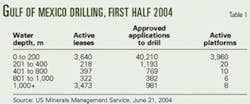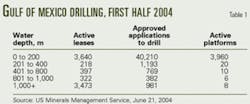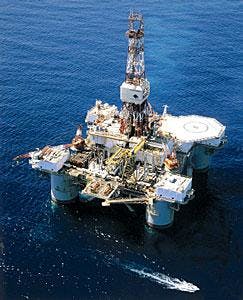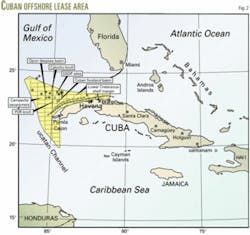Demand for drilling rigs is picking up worldwide and a shrinking Gulf of Mexico fleet is tightening the local market.
According to the US Department of the Interior's Minerals Management Service, 390 wells have been spud in the Gulf of Mexico in the first 6 months of the year. As of June 21, 2004, there were 40,210 applications approved to drill in Gulf of Mexico waters up to 200 m deep, most of which could be drilled with jack up rigs. There were also 3,325 applications approved for drilling in waters deeper than 200 m, all of which would require floating rigs (Table 1).
Central Gulf of Mexico Lease Sale 190, held Mar. 17, 2004, brought in $364,024,583 in high bids for 542 offshore tracts. Green Canyon Block 468, in 800-1,599 m water depths, attracted five bids including the highest bid of the sale, $35,290,892 from Amerada Hess Corp.
MMS said that the bidding indicated "the continued strong interest of major and independent oil and gas companies" in the gulf.
In May, MMS issued its deepwater Gulf of Mexico report, noting that about 750 deepwater wells have been drilled in the gulf since 1995, resulting in at least 100 deepwater discoveries.1
Reflecting the tightening market overseas and years of slim margins domestically, Global Industries Ltd. announced in a letter to customers in early June that it was "no longer willing to slash pricing" as required by many operators in the US Gulf of Mexico.
Because of what the company calls "onerous" contract conditions in the US gulf over the past 12 months, Global has moved assets from the gulf to the Bay of Campeche and the Mediterranean and will continue to redeploy as needed, it said.
Rig rates, counts, utilization
Day rates for deepwater rigs increased significantly from May 2004, according to ODS-Petrodata monthly offshore rig day rate indices, released June 11. The deepwater (5,001+ ft water depths) day rate index increased to 240, a level not reached since January 2002, because of new contracts. This reverses 3 months of declining rates for deepwater rigs.
The lowest day rate index (150) in the past 4 years was calculated in December 2003, and the highest (about 280) was in May 2001. The indices are based on the average market day rate in January 1994 equal to 100.
Utilization of deepwater rigs has been above 90% for the past year, with the exception of April-May 2004. ODS-Petrodata said about 24 deepwater rigs will come available through mid-September, and new contracts should command higher day rates.
The midwater (2,001-5,000 ft water depths) semisubmersible day rate index increased slightly to 161, the second highest level since May 2003. The highest day rate index for midwater rigs in the past year was March 2004 (about 195) and the lowest was September 2003 (about 125).
Utilization of midwater rigs has fluctuated mostly between 75-80% for the past year, listed at 75% for mid-June. ODS-Petrodata expects "little substantive change in this market."
In the US Gulf of Mexico, the ODS-Petrodata jack up day rate index increased to 148 in June, the second highest value since February 2002. Jack up fleet utilization is just under 80%, and ODS-Petrodata expects demand to increase and day rates to rise in the coming months.
The rig count in the US Gulf of Mexico is decreasing, according to the Baker Hughes International weekly rotary rig count for June 18, 2004. Rigs in the gulf dropped to 92, down 2 from the week before and 12 from a year earlier.
This downward trend is echoed for rig counts throughout North America, with 1,367 rigs operating in the US and Canada during the week of June 18, down 93 from the week before and 37 from a year earlier.
GlobalSantaFe Corp. had 15 rigs in the Gulf of Mexico in early June, but two left the region later in the month. Ten of the company's 46 jack up rigs, 2 of the 11 semisubmersibles, and all 3 of the company's drillships were in the gulf as of June 3. The GSF Adriatic II jack up was mobilized to Angola in late June, followed by a 30-month contract with a day rate in the mid-$50,000 range. The GSF Jack Ryan drillship mobilized to Brazil in mid-June for a 4-month contract with a day rate in the mid $140,000 range.
The company has moved only one other rig out of the Gulf of Mexico in the past 16 months: the GSF Adriatic IV cantilevered jack up (to North Africa, March 2003).
As of early June, Diamond Offshore Drilling Inc. had 20 rigs active in the US Gulf of Mexico, including 6 deepwater semisubmersibles, 3 midwater (second and third generation) semis, and 11 jack ups, many of which were coming off contracts in June-July. The company also has 4 semis off Mexico contracted through 2006-07, and 14 other floaters and 2 jack ups working internationally.
Ensco International Inc. plans to move two jack up rigs, ESV 93 and ESV 95, out of the Gulf of Mexico to the Middle East. The rigs were scheduled to move in third-quarter 2004 but will miss the contractual loading date with the heavy lift vessel.
Prudential Equity Group analyst Grant KD Borbridge said he expects the Middle East market "to be the world's hottest shallow water drilling market through 2004 and 2005." In his June 21 report, Borbridge said drillers could get $50,000/day in the Middle East for rigs that would earn $35,000/day in the US Gulf of Mexico.
GlobalSantaFe Corp.'s monthly SCORE (summary of current offshore rig economics) report issued June 21 showed a 2.1% worldwide increase from the month before, up 14% from a year ago, and up 66% from 5 years ago. There was positive market movement in May in the Gulf of Mexico (6.6%), Southeast Asia (5.9%), and West Africa (3%), and a downturn in the North Sea (–6%). The Gulf of Mexico showed the largest year-over-year improvement, increasing 35% from May 2003 and nearly 79% in the past 5 years.
The May 2004 SCORE for semisubmersible rigs increased 3.5% from April, and up 24% from 5 years ago. The SCORE for jack ups increased 2.3% from April and 113% from 5 years ago.
Gulf of Mexico projects
BP PLC plans to use GlobalSantaFe's new build semisubmersible Development Driller II for its Atlantis project in southern Green Canyon Block 743, in 6,500 ft of water. BP signed a 3-year contract, worth about $200 million, to drill about 20 wells, expecting to begin on July 1, 2005.
Atlantis is the third largest oil and gas discovery in the Gulf of Mexico, with about 575 MMboe. BP drilled the Atlantis discovery well in 1998 using Diamond Offshore's Ocean America semisubmersible (Fig. 1). Partner BHP Billiton Ltd. (44%) drilled the first appraisal well in 2000 using GlobalSantaFe's C.R. Luigs drillship, and the second appraisal well was drilled using GlobalSantaFe's Glomar Explorer drillship in the fall of 2001.
The Gulf of Mexico is a test bed for many new, innovative deepwater technologies. In 2003, Houston-based independent Mariner Energy Inc. spearheaded the use of dynamically positioned monohull multiservice vessels (MSVs) to install horizontal subsea trees and to plug and abandon deepwater wells with horizontal trees.
Mariner and partner Stone Energy Corp. used an MSV to install a horizontal tree on a wellhead in 1,144 ft water depth in the marginal Ochre field, Mississippi Canyon Block 66 (Offshore, February 2004).
Using an MSV for the tree installation saved about $100,000 in rig time, and the companies saved another $200,000 in rig costs because they didn't need to employ a rig with the crane capacity.
Mariner Energy is using the same ideas in developing the deepwater Swordfish project, in Viosca Knoll blocks 917, 961, and 962, in 4,500-4,700 ft water depths. Two wells were drilled in 2001, discovering oil and gas in multiple pay zones. BP E&P Inc. spudded the first well in VK 962 on Oct. 27, 2001, in 4,677 ft. water depth, and reached TVD of 13,760 ft on Nov. 15, 2001. Mariner spudded the second well in VK 917 on Nov. 21, 2001, in 4,370 ft water depth, and reached TVD of 12,912 ft on Dec. 8, 2001.
Diamond Offshore Drilling Inc.'s Ocean America semisubmersible drilling rig arrived on location in Viosca Knoll Block 961 on June 18 to drill the third well at Swordfish in 4,677 ft of water (Fig. 1). The Ocean America was built by Hyundai in Korea in 1988 and upgraded at Keppel AMFELS yard in 2004 to drill to 30,000 ft in waters up to 5,500 ft deep. Mariner Energy has a three-well contract for the Ocean America at a day rate in the mid-$70,000's until early October.
Mariner Energy Inc., a subsidiary of Mariner Energy LLC, operates Swordfish and has 15% interest. Majority stakeholder Noble Energy Inc. increased its working interest to 60% from 10%, after acquiring all of BP E&P Inc.'s interest in the project.
Burlington Resources Inc. holds the remaining 25% interest.
Deepwater gulf drilling in the first half of 2004 has resulted in eight new discoveries, including BP's Puma project in Green Canyon, Unocal Corp.'s Tobago prospect in Alaminos Canyon, Dominion E&P Inc.'s San Jacinto prospect in Desoto Canyon and Thunder Hawk prospect in Mississippi Canyon, Anadarko Petroleum Corp.'s Atlas NW prospect in Lloyd Ridge, Chevron USA Inc.'s Dawson Deep in Garden Banks, Noble Energy Inc.'s Ticonderoga in Green Canyon, and Kerr-McGee Oil & Gas Corp.'s Goldfinger in Mississippi Canyon.
Heerema Marine Contractors announced in early June that the company set two new industry records during installation of spars in Green Canyon's Atwater fold belt on the Outer Continental Shelf. The DCV Thialf made nine lifts for the Holstein spar, including the 2,564-tonne north module, a heavy-lift record for the gulf. The second record was accomplished from the DCV Balder, used to install the first 24-in. diameter, 11/8-in. WT steel catenary riser to the Mad Dog spar.
Bahamas
In June 2003, two affiliates of Kerr-McGee Corp. purchased nine exploration licenses off the Commonwealth of the Bahamas. The licenses cover 6.5 million acres in the Blake Plateau basin, in water depths from 650 ft to more than 7,000 ft.
In an interview published by the Nassau Guardian in February, Leslie Miller, minister of Trade and Industry, Commonwealth of the Bahamas, noted that fuel costs were higher in the Bahamas than elsewhere in the Caribbean and announced that the ministry is proposing to set up the Bahamas National Energy Corp. This company would transport crude oil from countries in Central and South America to Trinidad and Tobago, where it would be refined at cost before shipment on to the Bahamas, in an effort to reduce consumer costs by eliminating the profits taken by the three oil companies in the Bahamas (Shell Bahamas Ltd., Texaco Bahamas Ltd., and Esso Standard Oil SA Ltd.).
The BORCO terminal in Freeport is a former refinery turned into the Bahamas largest storage terminal. Owned by Petroleos de Venezuela SA, it has 43 storage tanks and transships oil in the region.
Cuba
Juan Fleites, vice-president of Cuba's national oil company, Cuba Petróleo (CUPET), spoke at the first Cuba-US trade round of 2004 in Havana in April. According to an Apr. 16 article in Granma International, Fleites said that exploration contracts for 10 of Cuba's 59 offshore blocks have been awarded. He said that 16 separate "prospecting and drilling" contracts have been signed with companies from Canada, France, and Spain.
Montreal-based Pebercan Inc. is technical operator for CUPET.
Cuba's Ministerio de Industria Básica (MINBAS) is responsible for overseeing the petroleum, minerals, and cement industries in Cuba.
Repsol YPF SA has contracted Ocean Rig ASA's Eirik Raude semisubmersible rig to drill the Yamagua-1 well off Cuba. The rig arrived in early June to begin the single-well contract at $195,000/day, expected to run through July-August. The Block 27 location is in 1,650 m of water, about 20 miles northeast of Havana and 95 miles southwest of Key West, Fla. (OGJ, Mar. 8, 2004, p. 42).
The northwest coast of Cuba is the principal area of oil and gas exploration activity, between Havana province to beyond the city of Cárdenas, Matanzas province (Fig. 2). This area has six exploitation blocks and produces 95% of Cuba's daily production.
In a presentation to Scotia Capital Materials Conference on June 2, 2004, Toronto-based Sherritt International Corp. said it holds 2 million acres of untested deepwater exploration blocks northwest of Havana. The company operates Block 7 along Cuba's north coast, in partnership with Cuba Petroleo, and claims to produce 60% of Cuba's oil, more than 40,000 b/d in 2003, steadily increasing from 24,000 b/d in 1999.
Sherritt also has a one-third interest in the Energas joint venture with 226 Mw capacity in place, generating 13% of Cuba's electricity from natural gas.
The company anticipates an 80-Mw expansion, beginning this year, but further expansion will be tied to gas availability.
According to a publication by the Alberta government, Canadian direct investment in Cuba is about $610 million (Can.) noting, "Canada has never observed the US embargo against Cuba, in place since 1961."2 The report said Sherritt International is the largest foreign producer of oil in Cuba. By August 2000, Sherritt had produced more than 30 million bbl since beginning operations in 1992.
Cuban production averaged 52,000 b/d in 2001, a year in which there were new developments in the Yumuri, Canasi, and Seboruco offshore fields, as well as workover efforts in mature, heavy oil fields onshore.
There was a miniboom in Cuban drilling in 1997-99, with about 13 wells drilled in 1997, 19 wells in 1998, and 19 in 1999 (all onshore).
According to a news report on June 1, Petrobras plans to construct a small lubricants plant in Cuba to supply Cuba and the Caribbean.
Elsewhere
According to Grenada Today, the national newspaper of Grenada, Carriacou, and Petite Martinique (Mar. 6, 2004), two local lawyers have called upon the Grenadian government to set up an oil and gas commission to prepare for oil exploration.
In April, Repsol YPF SA signed a 30-year production-sharing contract with the State Oil Co. of Suriname (Staatsolie) for Block 30, 100 km off Suriname (OGJ, May 10, 2004, p. 8). The contract provides for 6 years of exploration work.
The most recent drilling in the Guyana-Suriname Basin was in June 2000 by Toronto-based CGX Energy Inc. Drilling in the Corentyne Block was interrupted due to an ongoing border dispute between Suriname and Guyana.
Drilling offshore Nicaragua may begin in 2008 at the earliest, according to Rick Conrad, president of New Orleans-based MKJ Exploraciones Internationales Corp. Conrad told OGJ that a baseline environmental impact assessment would take at least 9 months, followed by 2D and 3D seismic, before any drilling.
The company wants to investigate Tertiary reef prospects at Isabel Bank (120 ft water depth) and Tyra Bank (900 ft water depth).
The Instituto Nicaraguense de Energia (INE) originally scheduled Nicar- agua's First Exploration Licensing Round for 1999, then postponed it until spring 2000, eventually offering blocks off the Pacific and Caribbean coasts, as well as inland in the First International Petroleum Round.
Awards were decided in 2003. Nicaragua's first petroleum concession contract, for a 342,275-hectare (about 845,420 acres) area in the southwest Pacific onshore, was signed with Industrias Oklahoma Nicaragua SA (Indoklanicsa) on Apr. 23, 2004.
INE says that negotiations to finalize concessions won by MKJ (24 offshore blocks consisting of 2 million acres) and Infinity Inc. should be complete "by next June."
There were 24 or 25 wells drilled off Nicaragua before 1979 by Unocal Corp., Mobil Oil Corp., Shell Nicaragua SA, Texaco Caribbean Inc., Occidental Petroleum Corp., and others.
Projections
Prudential analyst Borbridge believes that shallow water drilling markets in the Middle East and Asia-Pacific "should strengthen considerably in late 2004 and into 2005." He expects improvements in the global jack up market throughout the year, based on the effective utilization rate of 92%, but "continued depressed utilization and dayrates for midwater assets" (capable of working in less than 4,500 ft water depth).
He sees a moderate recovery in deepwater utilization and dayrates in the second half of 2004 as well as continued strength in international land drilling, based on strong upstream capital expenditure spending.
Raymond James analysts J. Marshall Adkins and John Freeman noted in their "Offshore Drillers" report in April that the near-term outlook is strong to rapidly improving for rig operators in shallow Gulf of Mexico, offshore Mexico, Southeast Asia, Middle East, Indian Ocean, and Trinidad. They see a slowly improving to stable rig market in the shallow North Sea and West Africa.
References
1. G. Ed Richardson, Leanne S. French, et al., "Deepwater Gulf of Mexico 2004: America's Expanding Frontier," May 2004, http://www.gomr.mms.gov/ homepg/whatsnew/techann/2004-021. pdf
2. http://www.iir.gov.ab.ca/international_relations/pdfs/3.3.2.6-%20Cuba. pdf



